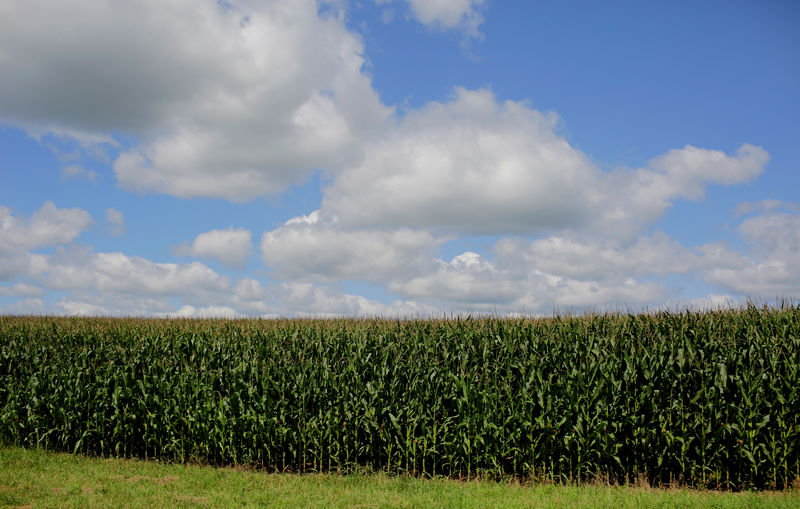By P.J. Huffstutter and Mark Weinraub
CHICAGO (Reuters) - Iowa corn farmer Bob Hemesath jokes that the government check he expects as compensation for his trade-war losses will soon allow him to splurge on upscale coffee in town instead of his usual burnt gas-station brew.
Rob Sharkey, an Illinois farmer, hopes his corn trade aid check will be big enough for that margarita machine he and his wife have been eyeing – but they doubt they'll be any left over for the booze.
Federal economists have calculated that the nation’s losses in corn - its largest crop by harvest and export volume - amount to just a penny per bushel, a pittance farmers call absurd. That's in stark contrast to the substantial $1.65 per bushel the government will pay for lost sales of soybeans, the crop hardest hit by retaliatory Chinese tariffs in a trade war launched by U.S. President Donald Trump.
Both subsidies only cover half the bushels harvested this fall, though the government could soon decide to apply more aid money to this season.
"You have to wonder why Washington even bothered" with the corn subsidy, said Sharkey, 43, a fifth-generation farmer. "The soybean payment? That's real money that can help us."
Even Sonny Perdue, Trump’s agriculture chief, fails to understand the pennies in trade aid. The U.S. Department of Agriculture secretary - a former farmer himself - recently told corn growers gathered in Champaign, Illinois, that the measly offering left him baffled and asking his agency's economists how they figured the number.
"We have got $1.65 on beans and a penny on corn? That doesn't make any sense'," he said. "If I were picking numbers, I'd have picked a different one."
But Perdue said the department was obligated to stick with the economists' algorithm because it mirrors what the U.S. would present to the World Trade Organisation when filing an unfair-trade grievance.
The USDA in August outlined how it would spend the first $6.1 billion of an authorized $12 billion aid package for farmers caught up in the trade war, including cash payments for farmers of grains, oilseeds, cotton, dairy and hogs.
The National Corn Growers Association has urged Perdue to change how the government calculates the economic bite of lost exports in its next tranche of trade aid, expected in December.
Some farmers cracked that they wouldn't stoop to pick up pennies off the ground, much less request them through bureaucratic forms.
"A penny is laughable," said Aron Carlson, a corn farmer and president of the Illinois Corn Growers Association.
USDA officials did not answer Reuters’ questions about how many farmers have applied so far for the corn trade aid. But government data gathered by the Environmental Working Group, a Washington, D.C.-based lobby group, from public records requests shows the United States had paid farmers $1.9 million for 12,807 corn claims as of Oct. 31.
The payouts ranged from $1 to $38,298, with an average payment of $147.
CRUNCHING NUMBERS, PINCHING PENNIES
USDA economists derived the miniscule payout to U.S. corn farmers through a formula seeking to estimate their economic damage - one many farmers call simplistic and lacking in common sense.
USDA economists ran an analysis of exports as a share of total production; the time it will take to adjust to new trade patterns; the observed price impact; and the measurement of how long it would take to burn through leftover supplies, the agency has said.
They looked at how much corn China and the European Union - two export markets that the U.S. has engaged in trade fights - imported from the U.S. in 2017. They then figured that the damage from the 25 percent tariffs on corn from China and the EU totalled $192 million. The USDA then divided that figure by the 14.6 billion bushels of corn that U.S. farmers harvested in 2017, bringing the per-bushel total to one cent - but only for half of all the bushels they harvest this year.
That approach does not account for the ripple effects the plummeting price of soybeans has had on the corn market, or the reduced demand from Mexico, which started buying more South American corn during the acrimonious negotiations that recently led to a new deal replacing the North American Free Trade Agreement (NAFTA).
It also does not factor in the impact of the Trump Administration’s multiple-front trade fights this year with many top agricultural markets on global exports of corn-related byproducts, such as ethanol and distillers dried grains.
The agency did throw corn farmers a bone: Calculations for the second tranche of trade aid expected next month may include the bids that cash merchants around the country were offering farmers for their grain, as well as other market conditions.
That's provided little consolation to farmers who watched prices for the Chicago Board of Trade corn futures contract that tracks the crop they harvested this fall
Corn futures have fallen another four cents since then as ongoing concerns about the fight with China that has weighed on soybeans have cast a pall across the entire agriculture sector.
LEAVE NO PENNY BEHIND
So far, $837.8 million of the total promised $12 billion has been paid out, according to the USDA. [L8N1XQ759]
For Indiana farmer Randy Kron, the corn trade aid means about $900, enough to pay for a few parts for his planter, or some seeds for next spring’s planting. His son, who helps them run their 2,200 acre crop farm, thinks the amount isn't worth the effort.
"He's tired of hearing his Dad preach to him about how bad it can get," said Kron, 57.
Kron said he will apply for the federal assistance nonetheless.

"I started farming in 1983," he said. "Back then, every penny mattered. We paid attention to pennies."